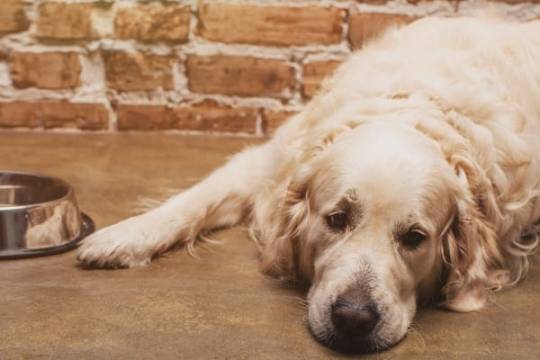Connect with a verified veterinarian in minutes. Licensed vets are available 24/7 to answer your questions. No need to worry about your furry family member.
If you’re new to breeding dogs, then there are a few things you’ll need to know. There are several factors that play into how many litters a dog can or should have.
In this article, we’ll talk about these various factors, including how many litters a dog can have. Let’s get started!
Breeding Dogs Responsibly
The first thing you’ll need to know is that it’s important to be a responsible breeder. This means always having your dog’s best interest in mind. Never breed only for monetary gain.
Before your dog can be bred, it’s essential to first ensure she’s healthy, sexually, and physically mature. And your dog needs to be of the right age to carry a litter.
Some dogs reach sexual maturity before they reach physical maturity. If you’re not whether or not your dog has made these crucial milestones, then it’s best to take her to the vet for a checkup. It’s a good idea to take her for a checkup, anyway, before she becomes pregnant. This way, you’ll know for sure your dog is healthy and ready to have a litter of puppies.
Your Dog’s Health
Your dog should be in tip-top health before becoming pregnant. This is imperative if you want her to stay healthy and have a healthy litter of puppies.
This means it’s essential to ensure your dog gets plenty of exercise and healthy food. Keeping her fit and happy goes a long way to getting her ready to have puppies.

Review symptoms, medications & behavior to keep your pets healthy with a Vet Online in just minutes.
Ask a Vet Live NowSexual Maturity vs. Physical Maturity
Another thing you need to be aware of is the difference between sexual maturity and physical maturity. These vary by dog breed. In general, experts agree that a female dog is both sexually and physically mature after her second or third heat cycle. This does vary between dogs and breeds, however.
It’s necessary to wait until your dog has become an adult before she has puppies. This means waiting until after she’s had her second or third cycle. Then you can be assured she’s reached her adult size and weight. She will also be more mature and better able to look after a litter of puppies.
The reasons to wait until your dog is mature include:
- If she’s too young, the dog will still be growing. She may not be able to carry a litter of puppies and could become sick.
- It’s best to have your dog checked by the vet to make sure she doesn’t have any medical issues and is an adult before breeding.
- If a female dog is too young, she may have trouble caring for her puppies. If that happens, the pet parents or the breeder need to raise the puppies. What’s more, the puppies may suffer from the want of their mother’s attention. This can lead to behavioral and other problems in the puppies later.
So, it’s safe to say that most dogs are able to mate when they’re around 2 to 3 years old. This can vary—in larger breeds, for instance, the female may not be ready to mate until she’s about 2.5 or older.
Is it Safe for Older Dogs to Have Puppies?
It is possible for older dogs to have puppies; however, it’s not recommended. Most reputable breeders stop breeding their dogs between the ages of five and seven years. By this age, a dog may start to have problems birthing the puppies. This can result in losing the mother dog, as well as the puppies. It’s also possible an older dog may miscarry the entire litter of puppies.
Pregnancy Cycles in Dogs
The first heat of the cycle is called estrus. During this time, your dog will become very sexually active. Her vulva will become very moist and swollen. This is a normal process for all female dogs during this time.
The second heat of the cycle is called diestrus. During this time, your dog will become less sexually active. Her vulva will become dry and swollen. During the third heat of the cycle, called proestrus, your dog will begin to ovulate and have sexual intercourse with males. This can occur in any month of the year, but most often occurs in late winter or early spring.
During estrus, your dog will be very sexually active and have multiple mating partners. Some females will mate more than once per day during this time. These are called polyestrous females and are common in many breeds of dogs including Labrador Retrievers, Australian Shepherds, and German Shepherds.
In most breeds, the pregnancy cycle lasts about 63 days, which is just over two months. Your dog will go through many changes during this time. In the beginning, you may notice anything too different with your dog. However, the vet may be able to see the puppies in an ultrasound when the pregnancy is at about three weeks.
From there, you’ll notice more obvious changes. These will include a little bit of a bulging belly, and the dog’s nipples will become larger.
Dog owners will notice their dog’s abdomen is starting to get larger. At this point, your dog will have a much more difficult time walking. You may also notice that your dog has a heavy breathing pattern. The first time you will see your dog’s puppies will be when they are born.
When a female dog has her puppies, she will become much more vocal. She may even get quite excited. However, this excitement should not be mistaken for the mother being anxious to have her puppies. In fact, a female dog is usually very protective of her pups.
Just before birth, an ultrasound will show how many puppies your fur baby is carrying! From that time, you’ll only need to wait a few days, and the puppies will come! It’s so exciting!
Dog Litter Size
The average litter size of a female dog is between 1 and 12 puppies. The number of puppies a female dog has depends on a number of factors. Some of these factors include the following:
- Age of the dog
- Nutrition and medical conditions of the dog
- Age of the male dog involved in the breeding process
- Size and health of the female dog
- Number of times that a female dog has been bred before
This information is not accurate for every female dog, however. Not all dogs will have 12 puppies from one breeding. Some dogs may have only one or two puppies from each litter. Sometimes, there are many factors that determine how many puppies a female dog will have in her lifetime. These factors include genetics, diet, and environmental influences on reproduction.
Different breeds of dogs have different litter sizes. Large breeds like German Shepherd, Mastiff, Golden Retriever, Bulldogs, and Great Dane have different average litter sizes. Smaller dogs like Chihuahua, Dachshund, and Pekingese have smaller average litter sizes.
Dog pregnancy is often a long process. During this time, she will be cycling and may be bleeding. It is important to check your dog’s blood levels during this time to make sure that she is not anemic. If you see that your dog is anemic, it is important to take her to the vet as soon as possible.
How Many Times Can You Breed a Female Dog?
Female dogs are not able to breed as often as a male can mate. So, how many litters can your dog have? The highest number of litters any female dog should have is three or four. No more. This is because it takes time to recover. It also depends on her overall health.
If a female dog has more than four litters in her lifetime, her health will definitely suffer. Too many pregnancies could even shorten her life.
So, a female dog, on average, should have no more than three or four litters in her lifetime.
Recovery Time Between Pregnancies
Recovery time is regulated in some countries. For instance, in Finland, you must wait at least ten months from the time a dog gives birth to breeding her again.
The recovery time is essential for female dogs. Consider that they go through almost three months of pregnancy. Then they give birth and care for the puppies, nursing them regularly, and more. This all takes a toll on the dog’s body. Recovery time is imperative for her health and the health of her future litters.
Health Problems During Pregnancy
Some of the health problems that may occur during pregnancy in dogs include:
Vomiting: This is a common problem that can occur during pregnancy. The cause of vomiting is usually food or water. A dog may vomit after she eats something that doesn’t agree with her, or if she eats too much food too quickly. In some cases, the dog may vomit if she ate something poisonous. Vomiting can be an indicator of something more serious, such as poisoning.
Abdominal pain: This can be a sign of an abdominal mass, such as a tumor. Abdominal pain can also be caused by constipation. If your dog has an abdominal mass, you should contact your veterinarian right away.
Lack of appetite: This is also a common problem that occurs during pregnancy. Many dogs experience loss of appetite, but this may not be the case with all dogs. If your dog has a loss of appetite and refuses to eat anything, you should talk to your veterinarian about it right away. A vet can recommend steps that will help you get your dog’s appetite back on track.
Back-to-Back Breeding
Back-to-back reeding is not acceptable, though there are breeders who practice this with their female dogs. They believe their dogs are healthy enough for this practice and that it doesn’t hurt them at all. However, with this breeding method, female dogs have time to recover in between pregnancies. And this can be damaging to their health.
So, there you have it! For female dogs who are healthy and of the right age, they can have about three or four litters over their lifetime, not more.
Whelping
A whelping is the birthing of a litter of puppies. This can be a very stressful time for both the mother and the puppies. During this time, the mother will want to be with her puppies, but she will also be very protective of them. This can cause a lot of conflict between the mother and the human family members.
The best way to handle this is to provide plenty of stimulation for your dog during this time. This will help her through this stressful time. You can even consider providing your dog with a whelping box to help her with this process.
Many people use whelping boxes in order to make the process easier on their dogs. The dogs are able to give birth without having to worry about damaging furniture or carpets. These boxes are also used by many people who have a dog that has problems with giving birth naturally in a normal environment. These boxes are usually used in conjunction with medication and regular veterinarian visits for help during this time.
It is very important that you have everything ready for whelping. You will need the following:
Food and water bowls, dog dishes, puppy pads, and a litter box. You will also need a cage for the mother dog to give birth in. You can buy a used crate from your local pet store or ask your veterinarian if they have any available for you to use.
If you do not have the proper supplies, then you will need to take your dog to the veterinarian. The vet will be able to give you everything that you need for whelping.
Final Thoughts
A dog’s life is filled with a lot of changes. These changes are usually not very well understood by the people around them. If you want to help your dog with these changes, you should understand the things that are happening to her.
Provide plenty of stimulation for your dog during this time. This will help her through this stressful time. You can even consider providing your dog with a whelping box to help her with this process.
We hope this has answered your questions! If not, then be sure to call your vet and discuss your dog breeding & pregnancy questions with them!
Connect with a verified veterinarian in minutes. Licensed vets are available 24/7 to answer your questions. No need to worry about your furry family member.

Kyoko
Kyoko is from a family of 3 and moved to New York with her parents and siblings when she was 13. Kyoko is fond of spending a great amount of time with pets, specifically her beagle Luna and cat Missy. Her boyfriend often complains that she spends too much time giving attention to their animals. Kyoko has written dozens of articles concerning pets and is aiming at owning a pet shop one day!
Review symptoms, medications & behavior to keep your pets healthy with a Vet Online in just minutes.
Ask a Vet Live Now




